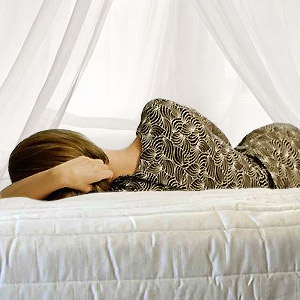Sleep Disorder Test

Sleep is essential for life. Sleep restores the energy levels of the body and prepares you to welcome the day with full vigor. Unfortunately many people suffer from disordered and abnormal sleep. There are a few sleep disorder tests that are often conducted by doctors in cases where the patient is suffering severe sleep related issues. It aids in the process of better sleep management.
Sleeping disorders
Many types of sleeping disorders have been identified by the medical fraternity, and they can be broadly categorized into:
- Insomnia: Inability to get good quality sleep due to stress, depression and host of other health reasons
- Sleep apnea: In sleep apnea breathing is temporarily stopped for ten or more seconds at frequent intervals. This condition may be caused by blocked airflow, narrowed airways or other breathing difficulties
- Narcolepsy: It is a neurological disorder that is characterized by uncontrollable and
excessive sleepiness .People with narcolepsy may also fall asleep instantly without prior indication.
- REM sleep disorders: REM (rapid eye movement) is an important stage of sleep and body
muscles are temporarily paralyzed during this stage. . Patients with REM disorders may enact their dreams.
- Sleep walking, night terrors, bed wetting.
- Shift work sleep disorder: People involved in day/night shift jobs are prone to
this kind of disorder
- Restless leg syndrome: Persons tend to move the legs repeatedly to overcome the itchy
sensation thus causing poor quality sleep.
Sleep disorder testing
Sleep disorders may creep into other areas of health if left undiagnosed and untreated. As there are various types of sleep disorders, medical professionals take the help of sleep disorder tests to identify the type and intensity of the disorder. These tests analyze the sleep patterns, identify the underlying causes and help the doctor in determining the appropriate treatment and medication.
Types of sleep disorder tests:
Some of the common sleep disorder tests include:
- Overnight oximetry
- Polysomnogram
- CPAP titration test
- Multiple sleep latency test
- MWT(maintenance of wakefulness test)
- Actigraphy
Overnight oximetry: Oximetry test measures the heart rate and the level of oxygen in the blood. This is done by using an oximeter, a photo electric device that is placed on the finger or on the earlobe. Oximeter with the help of a sensor records heart rate and the level of oxygen. Any dip in the oxygen level or rise in the heart rate may mean there is a pause in the breathing thus indicating the presence of sleep disorder.
Polysomnogram: It is a widely used test that records bio-physiological activities of the patient while he is asleep. The activities may include breathing, muscle movement, oxygen level in the blood, movement of eyes etc. The data thus recorded is utilized to recognize the type of sleep disorder the patient is suffering from.
CPAP (continuous positive air pressure) Titration test: If polysomnogram detects or suspects sleep apnea, patient may be subjected to titration test. Under this test a technical person will adjust air pressure (cpap) through a mask to the level that eliminates or minimizes sleep apnea
Multiple sleep latency test (MSLT): MSLT monitors the severity of the sleepiness during day time. The test records the time taken by the patient to fall asleep (known as sleep latency) and the amount of REM sleep occurring. Test is repeated four to five times in a day, after a gap of few hours in between the tests. MSLT is recommended to those who are suspected to have narcolepsy.
Maintenance of wakefulness test: MWT analyses the patient's ability to stay awake during day time. MWT like MSLT is conducted four to five times in a day. The results of MWT are used in determining the line of treatment for daytime sleepiness.
Actigraphy: In actigraphy, a small watch-like device called actigraph is tied to the wrist of the patient for one or two days. This device notes down the duration of sleep and wakefulness and gives an understanding about sleep schedule of the patient.
The outcome of these tests provides key information regarding sleep stages, abnormal breathing, level of oxygen in the blood, body movements etc. and aids the doctor in designing a treatment plan
Top of the Page: Sleep Disorder Test
Tags:#sleep disorder test #sleep disorder testing
Cause of Insomnia
Insomnia and Weight Gain
Narcolepsy
Excessive Daytime Sleepiness
Sleep Apnea
Sleep Deprivation in Women
Sleep Deprivation
Power Nap
Sleep Disorder Test
Snoring Treatment
Other health topics in TargetWoman Women Health section:
General Women Health

Women Health Tips - Women Health - key to understanding your health ...
Cardiac Care
Women's Heart Attack Symptoms - Identify heart problems...
Skin Diseases
Stress Hives - Red itchy spots ...
Women Disorders
Endocrine Disorder - Play a key role in overall wellbeing ...
Women's Reproductive Health
Testosterone Cream for Women - Hormone replacement option ...
Pregnancy
Pregnancy - Regulate your lifestyle to accommodate the needs of pregnancy ...
Head and Face
Sinus Infection - Nearly 1 of every 7 Americans suffer from ....
Women and Bone Care

Slipped Disc - Prevent injury, reduce pain ...
Menstrual Disorders
Enlarged Uterus - Uterus larger than normal size ...
Female Urinary Problems
Bladder Problems in Women - Treatable and curable ...
Gastrointestinal Disorders
Causes of Stomach Ulcers - Burning feeling in the gut ...
Respiratory Disorders
Lung function Test - How well do you breathe ...
Sleep Management

Insomnia and Weight Gain - Sleep it off ...
Psychological Disorders in Women
Mood swings and women - Not going crazy ...
Supplements for Women
Women's Vitamins - Wellness needs...
Natural Remedies

Natural Diuretic - Flush out toxins ...
Alternative Therapy
Acupuncture Point - Feel the pins and needles ...
Top of the Page: Sleep Disorder Test
Popularity Index: 100,485

